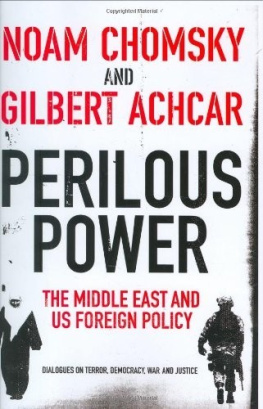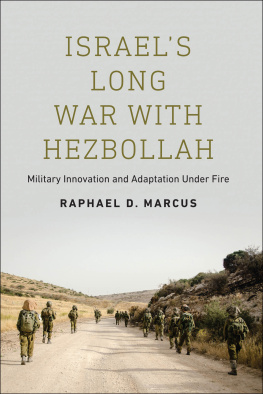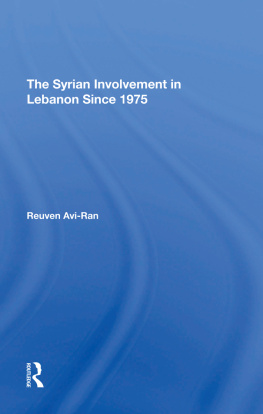THE 33-DAY WAR
Israels War on Hezbollah
in Lebanon and Its Consequences
GILBERT ACHCAR
WITH MICHEL WARSCHAWSKI
First published 2007 by Paradigm Publishers
Published 2016 by Routledge
2 Park Square, Milton Park, Abingdon, Oxon OX14 4RN
711 Third Avenue, New York, NY 10017, USA
Routledge is an imprint of the Taylor & Francis Group, an informa business
Copyright 2007, Taylor & Francis
All rights reserved. No part of this book may be reprinted or reproduced or utilised in any form or by any electronic, mechanical, or other means, now known or hereafter invented, including photocopying and recording, or in any information storage or retrieval system, without permission in writing from the publishers.
Notice:
Product or corporate names may be trademarks or registered trademarks, and are used only for identification and explanation without intent to infringe.
Library of Congress Cataloging-in-Publication Data
Achcar, Gilbert.
The 33-day war : Israels war on Hezbollah in Lebanon and its consequences / Gilbert Achcar; with Michel Warschawski.
p. cm.
Includes bibliographical references and index.
ISBN-13: 978-1-59451-408-1 (hc: alk. paper)
ISBN-10: 1-59451-408-9 (hc: alk. paper)
ISBN-13: 978-1-59451-409-8 (pbk: alk. paper)
ISBN-10: 1-59451-409-7 (pbk: alk. paper) 1. Lebanon War,
2006. I.
Warschawski, Michel. II. Title.
DS87.65.A24 2007
956.92044dc22
2006038808
Designed and Typeset by Straight Creek Bookmakers.
ISBN 13 : 978-1-594-51408-1 (hbk)
ISBN 13 : 978-1-594-51409-8 (pbk)
Contents
The Thirty-Three-Day War that Israel waged unsuccessfully against Hezbollah in Lebanon, from July 12 to the dawn of August 14, 2006, has in Arab minds already compensated for the humiliation of the Six-Day War waged from the dawn of June 5 to the evening of June 10, 1967. Conversely, it has set off a major crisis within the Zionist state, where Lebanon confirmed its image as Israels Vietnam, the image it acquired at the time of the Israeli withdrawal from southern Lebanon in 2000, after eighteen years of occupation.
The war of the summer of 2006 has been classified in various ways, as either the sixth round of the Arab-Israeli war1948, 1956, 1967, 1973, 1982, 2006or the third Israeli invasion of Lebanon1978, 1982, 2006. (Curiously enough, Israels invasion of southern Lebanon in 1978 as well as the actual war that Israel has been waging against the Palestinian territories since the fall of 2000 are generally not counted among Arab-Israeli wars.)
This series of dates is an eloquent testimony to the gravity of a situation that became an endless tragedy several decades ago. The escalation in the intensity of violence from one war to the other, along with the technological evolution of the armament used on both sides, points to a frightening future. This happens at a time when a new wave of nuclear proliferation is unfolding worldwide, increasing year after year the likelihood that weapons of mass destruction will be used, whether by states or by organizations.
Moreover, of all the hot zones of the world, the Middle East is the one that has generated and continues increasingly to generate the highest amount of violence on a world scale, beyond the zone itself. That is why conflicts in the Middle East attract more attention than those of many other areas: Regularly and brutally, they remind the rest of the world of their existence.
This book presents an analysis of the Thirty-Three-Day War in the context of the evolution of Lebanon on whose soil it largely took place, with a focus on its consequences in Lebanon as well as in Israel. It is meant for those who seek a synthetic introduction to this extremely complex problem as well as for those who know the facts already and seek a discussion of their interpretation and of the prospects of this explosive situation.
The authors belong to the two countries that were directly involved in the war of the summer of 2006, the two enemy states of Israel and Lebanon. Their friendship is more than thirty years old and is all the stronger for transcending the burning border separating their two countries. It is based on their common dedication to the motto of the French Revolution that they learned in school as part of the French education that they share: Liberty, Equality, Brotherhood (and Sisterhood). Michel Warschawski wrote , which is devoted to Israel (Marie Stuart translated it from the French); Gilbert Achcar is the author of the rest of the book.
October 15, 2006
1
Lebanon, from Its Origins to July 12, 2006
As an independent state, as well as of the global Cold War.
Within its present borders, drawn by the authorities of the French colonial mandate over Syria and Lebanon in 1920, the Lebanese state was built on a precarious religious equilibrium: The enlargement of the borders of the original Lebanese entity created a country with a small Christian majority, mainly Maronite.formula based on a sectarian sharing out of powers that was going to last.
The National Pact on which independent Lebanon was foundeda 1943 agreement between representatives of the Lebanese dominant classes belonging to the major religious communitiessanctioned the sectarian distribution of positions and seats in the Lebanese state according to a rule that gave a 611 majority to Christians. It set up Lebanon on two negations, as Lebanese editorialist Georges Naccache aptly and famously put it: The Christians renounced French protection, and the Muslims gave up the demand of Greater Syrian unity, for a sovereign Lebanon whose Arab character was vaguely recognized. Fifteen years later, this pact was put to a major test for the first time.
In 1958, the first civil conflict in the history of independent Lebanon resulted from the clash between two opposite pressures: on the one hand, the impact of Nasserism with its call for the unification of the Arab nation, inaugurated the same year by the union between Egypt and Syria; and, on the other hand, the vehement rejection of this perspective by a segment of the Lebanese population, largely consisting of Christians. Lebanese President Camille Chamoun supported the Eisenhower Doctrine and the Baghdad Pact, and sought to incorporate the country in the Anglo-American regional strategic system.
This first conflagration, which did not last long, led to the landing in Lebanon, in July 1958, of the Marines sent by U.S. President Dwight Eisenhower. It ended in a compromise that put in power General Fuad Chehab, who ruled the country in a Bonapartist fashion, combining authoritarian power based on the military apparatus, arbitration between the various communities, and administrative and social reformism. This compromise exploded under the shock of the June 1967 Arab-Israeli war: Although Lebanon was not directly involved in that war, it suffered its consequences in full as it sheltered since 1948 the second-largest number of Palestinian refugees (after Jordan). Radicalization of Palestinians as an outcome of the war, amplified by that of a segment of the Lebanese population, mostly Muslims, disrupted the precarious equilibrium of Chehabism, prompting another segment, mostly Christians, to throw itself again into Washingtons arms.
Meanwhile, social tensions had considerably sharpened in Lebanon. The rapid economic growth of the 1950s and 1960s had disproportionately benefited various regions and communities. Whereas the capital and adjacent regions with a Maronite majority thrivedBeirut became an important transport, trade, and finance hub for the whole of the Arab Middle Eastthe outlying regions, with a Shiite majority, located all along Lebanons terrestrial borders, were left behind this dazzling growth.
Next page











